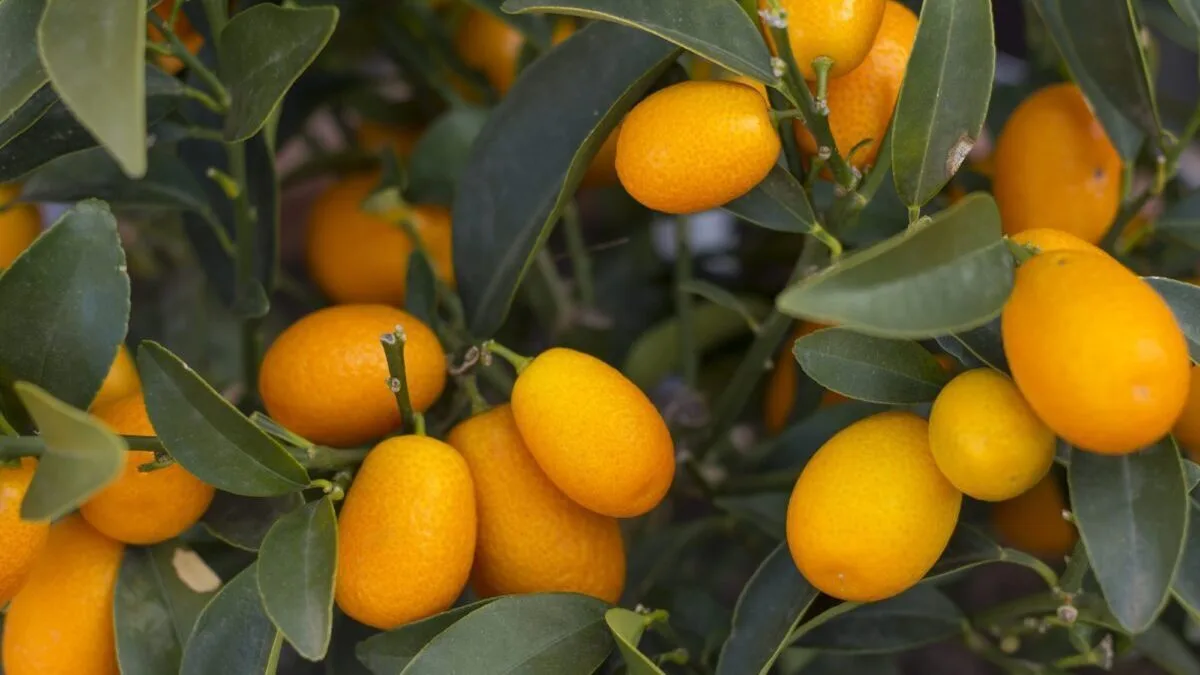Table of contents
Kumquat Tree Varieties
Good kumquat tree care should see this attractive garden tree produce fruit for you. The kumquat tree has the botanical name Citrus Japonica.
This fruit tree came from China and is associated with the tropics and eastern Asia. They are relatively small and quite attractive for the suburban garden. While there are a number of varieties of kumquats, the most popular are:
- Nagami
- Marumi
- Meiwa
Kumquat Tree Grow from Seed
Kumquats do not grow well from seeds and are overwhelmingly grown by grafting. Consequently this is done by using the rootstock of another citrus fruit.
Kumquat Tree Height
Kumquat trees grow up to 5 metres (16.5 ft) in height. However, you may prefer the dwarf variety which grows to around 2.5 metres (8 ft) in height.
Kumquat Tree Care Outdoor
2 minutes 3 minutes
How to grow kumquat trees from cuttings.
- Select Cutting
Make sure the cutting has 3 nodes (nodes are the knobby areas on the stem from where the leaves grow).
- Apply hormone
Put the end of the cutting into the rooting hormone mixed with water.
- Pot
Push a small hole in your potting mix. Next, put the cutting in the hole and firm up the soil so it can stand on its own. Also make sure the soil is damp to the touch, but not water-logged.
- Transplant
When your seedling fills the pot, transplant it into your final growing spot in your tropical garden.
Location and Soil
Kumquat trees will grow in most soil types, regardless of the ph. However, they should be planted in a well draining location. While they thrive in the tropics they can survive in areas with temperatures down to – 8 Celsius (18F).
This tree thrives in full sunlight and enjoys high humidity of 50 to 70 per cent.
Fertilising
In spring, you should fertilise kumquat trees with a slow-release citrus fertilizer.
During the growing season, regular applications of a liquid fertilizer can increase a trees growth and productivity.
Make sure you water your tree well before and after you apply the fertiliser. Otherwise you may burn the plant.
Kumquat Tree Pruning
Kumquat tree care can include pruning. However, any pruning should be done in the dry season (winter/spring).
Also cut diseased branches back completely, by pruning into healthy wood on the branch above any diseased portion.

Watering
You should water trees regularly throughout the dry season. However, during the ‘wet’ they will be fine without any additional water. You should keep the ground at the base of the tree moist, but not wet or soggy. Mulching is recommended.
Kumquat Tree Problems
Root rot can be a problem with kumquat trees. So while mulching is recommended, you should pull back the mulch a few centimetres from the base of the tree.
The pests of kumquat trees include mealybug, aphids and fruit fly. However, regular application of ‘white oil’ can help address some of these pests. Indeed, white oil is an effective organic pesticide that you can make at home.
Neem oil is also an organic solution to pests which is effective against certain insect and fungal disease. It is a useful tool in your kumquat tree care.
Kumquat Tree Care Indoors
When grown indoors, they probably won’t reach full size, but they will still have the potential to produce lots of fruit. There are several dwarf varieties that are ideal for indoor growing.
The main thing is to ensure your kumquat tree gets as much bright light as possible and to use a supplemental grow light if necessary. If you live in a colder climate where sunlight goes away at different times of the year, you will need a grow light.
Growing Kumquats in Pots
Kumquats are one of the easiest fruit trees to grow in a pot. However, if you do place your plant inside, make sure it is located where it will get as much light as possible.
There is no problem growing the kumquat tree in pots. A great many people do this successfully.

When do kumquat trees bear fruit?
Kumquats are typically ready to be harvested during the winter months, which generally fall between June and August. The exact time may vary depending on the specific variety of kumquat and local growing conditions, but the fruit is usually ripe when it has turned a deep orange colour and feels firm to the touch.
In the tropics some trees are fruiting all year round.
Eating The Fruit
Kumquats are best eaten raw. However, do not peel before eating, as the sweet skin complements the more bitter flesh of the fruit. Make sure you spit out the seeds!
Health Benefits of Kumquat Tree Care
Kumquats are low in sodium and devoid of fat and cholesterol. In addition, they offer a number of other health benefits.
Weight Loss
Kumquats are also low in calories yet high in fibre. As a result, they are an excellent addition to a weight loss diet. Indeed, adding kumquat to your diet is a useful way to curb cravings and boost weight loss.
Fibre
The high fibre and water content in kumquats makes them filling and good for digestion. Consequently, they can also help with constipation.
Immune System
The fruit is also very high in vitamin C which boosts the immune system. Indeed each fruit contains around 8 mg of vitamin C.
Antioxidants
The edible peels are full of antioxidants. Consequently, they contain compounds that support the immune system and lower the risk of certain cancers.
Kumquat Tree for Sale
Consider visiting a local plant nursery to purchase your tree. You may be surprised with what they have to offer.
Other Tropical Fruits
- Australian Finger Lime
- Black Sapote
- Custard Apple
- Dragon Fruit
- Grumichama
- Guava Tree
- Jaboticaba Tree
- Lemonade Tree
- Mamey Sapote
- Meyer Lemon
- Mulberries
- Natal Plum
- Passion Fruit
- Paw Paw
- Rambutan
- Star Apple
- Watermelon


Comments
2 responses to “Kumquat Tree Care Guide”
[…] Kumquat […]
[…] Kumquat Tree […]